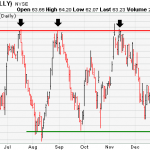The Law of Charts defines four basic formations known as 1-2-3 lows and highs, Ross hooks, trading ranges, and ledges. These occur in all time frames because the depict human action and reaction vis-à-vis price movement. What makes these formations unique is that they can be specifically defined. The ability to formulate a more precise definition sets these formations apart … [Read more...]
How to Use Technical Analysis Indicator
Indicators are calculations based on the price and the volume of a security that measure such things as money flow, trends, volatility and momentum. Indicators are used as a secondary measure to the actual price movements and add additional information to the analysis of securities. Technical Analysis is an inexact science. It is a method used by technical traders to research … [Read more...]
Intraday and intraday trading
INTRADAY During a single trading day.Another way of saying "within the day". Intraday price movements are particularly important to short-term traders looking to make many trades over the course of a single trading session. The term intraday is occasionally used to describe securities that trade on the markets during regular business hours, such as stocks and ETFs, as opposed … [Read more...]
Support and Resistance
Support and resistance represents key junctions where the forces of demand and supply meet. In the financial markets, prices are driven by excessive supply (down) and demand (up).As demand increases, prices advance and as supply increases, prices decline. When supply and demand are equal, prices move sideways as bulls and bears slug it out for control. What Is Support? The … [Read more...]
